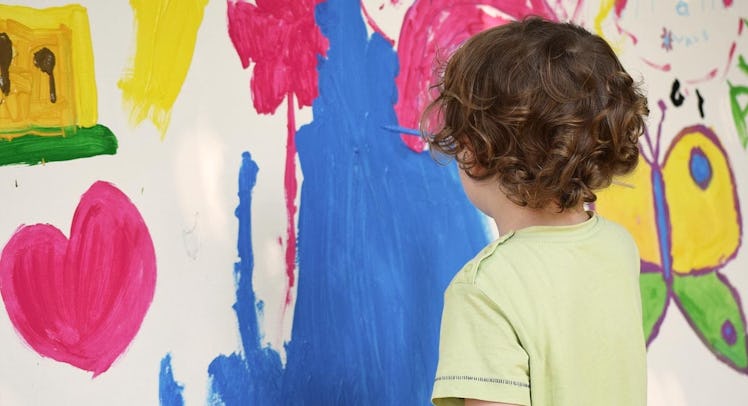A Professional Artist On How You Can Encourage (And Improve) Your Kid’s Drawing Ability
Drawing from the source.

Your kids draw. A lot. On paper, napkins, the walls, and — too often — each other. Now, they’re getting better: What were once scenes of murder by crayon, are now pictures of houses with doors and windows and portraits of you that kind-of, sort-of do look like you … If your arms grew out of your head, which they thankfully do not. Progress!
That’s the big secret to drawing: If your kids want to become mini Matt Groenings or Édouard Manet, then they have to get their doodle on as often as possible. But, as with most activities, the act of drawing can get stale — and one’s ability can grow stagnant — if you don’t switch things up. Chris Locke, an acclaimed illustrator, sculptor, and author of Draw Like This: How Anyone Can See the World Like an Artist—and Capture It on Paper, has keyed in on several simple strategies to not only teach kids to be better drawers but also keep them more entertained when the colored pencils appear.
Get Your Grid On
One of the best ways to improve a kid’s drawing? Get your grid on. “Just lay a grid of squares over a picture that you want to copy,” says Locke. “Go one square at a time, looking at just what’s in that square.” This simple switch up helps the artist focus on minute details they might otherwise overlook, especially if you’re working with an enlarged version of the picture you want to recreate. “It also forces the artist to slow down,” Locke says. “If you were copying a picture of somebody, you might look at it and go ‘Well, I know what an eye looks like,’ and then you’d just draw what you think an eye looks like. But when you break it into tiny pieces — and you’re drawing just the corner of the eye — you slow down and pay closer attention.”
See Things From The Flip Side
Literally. Whether your kid’s drawing a horse or a house (or a househorse, because, kids) have them flip the inspiration upside down. Like grid drawing, this helps the artist notice more things about their subject. “When you draw something upside-down,” explains Locke, “you really have to pay close attention: What direction does that line go? How does this thing intersect with that thing? What shape is this horse?” In other words: When you dismantle your preconceived notions of what a thing should look like, you may just recognize what it does look like. Heady, right? Yeah. Heady like a househorse.
Draw Without Looking Down
Drawing is as much a mental pursuit as a physical one, which means you have to focus on exercising the muscles of the body and the brain. Which should not be taken as a suggestion for your kid to bang out some leg sets before art time. Instead, Locke teaches his students to draw without looking at their paper, an exercise called blind contour drawing. “It really wakes up certain parts of the brain that are just not appreciated,” he says. “It forces you to pay close attention to what direction something points, how shapes go together.” Locke says to have your kids start out easy, then work their way up to longer and longer sessions. “Do some short drawings — 30 or 45 seconds — and then increase the time,” he says.
Set Some Time Limits
One of the exercises Locke says kids enjoy most is drawing under a time limit. This forces the artist to make exciting decisions about what is truly important about the thing they’re drawing. “I have them draw a car in 9 seconds or draw a house in 11 seconds — some very small arbitrary thing to draw, and a small arbitrary time limit,” he says.
And the kids dig it. “I start off having everybody draw a cheeseburger in 1 minute. When they’re done, I say, ‘Now draw a cheeseburger in 30 seconds,’ and they laugh, and I say ‘Now draw a cheeseburger in 15 seconds.’ And for that fifteen seconds they’re so intensely focused, there’s this whole tension in the room, and when it’s done everybody’s just laughing.”
The Bottom Line
“Everybody says drawing is a talent,” he said, “but I say it’s a skill that you get over time, working really hard. If you want to speak a second language, nobody’s born with that. You have to work.” But he says a close second is confidence: To make a good drawing, you’re gonna have to make a lot of bad ones first. “When you tell yourself you can’t do it,” he reflected, “you’re not going to get better at it.”
For Locke, learning from mistakes is a very tangible part of the process — so tangible, in fact, that he says he “rarely ever” uses an eraser. “I think I’ve had the same eraser for 6 or 7 years,” he said. “I do a drawing and then I make all the changes on it in pencil. Then I put a fresh sheet of paper over that, and trace it.” And that might be the most valuable tip of all: You can always get a fresh sheet of paper. Or a new section of wall. Whichever.